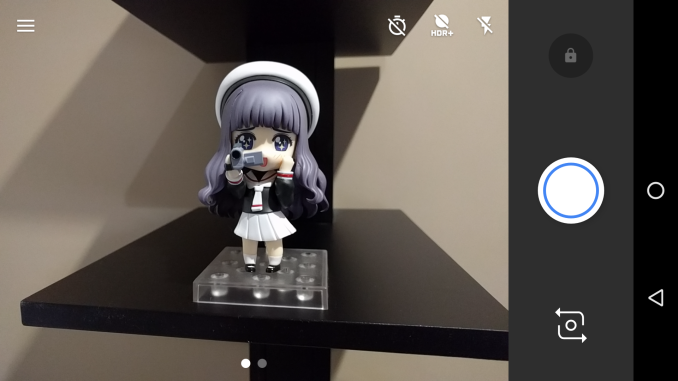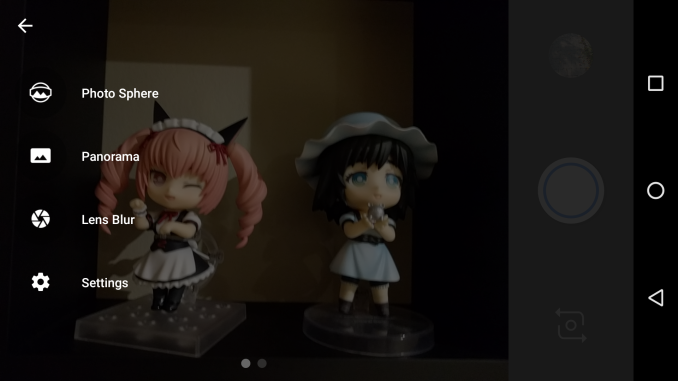The Google Nexus 5X Review
by Brandon Chester on November 9, 2015 8:00 AM EST- Posted in
- Smartphones
- LG
- Mobile
- Android 6.0
- Nexus 5X
Camera Architecture
While there have been some notable exceptions, the trend with smartphone camera sensors has been toward smaller pixels for quite some time now. HTC tried to combat this with their 2.0 micron pixel 4MP UltraPixel sensor, but the lack of spatial resolution ultimately made it difficult to market and less than optimal in the daytime. Apple went for a different balance with an 8MP sensor with 1.5 micron pixels in the iPhone 5s and 6. However, to add functionality like 4K recording while also being unable to increase sensor size without thickening their phones, they had to step down to 1.22 micron pixels in the iPhone 6s. Moving to smaller pixels has the unfortunate side effect of reducing your signal to noise ratio (SNR), and ultimately even if you push a larger sensor size with 1.1 micron pixels you're likely to run into more issues with noise than a sensor of the same size with larger pixels.
| Google Nexus 5 | Google Nexus 6 | Google Nexus 5X | |
| Front Camera Resolution | 1.2MP (1280 x 960) |
2.1MP (1920 x 1080) |
5MP (2592 x 1944) |
| Front Camera Sensor | Aptina MT9M114B (1/6", 1.9µm) |
Aptina AR0261 (1/6", 1.4µm) |
Omnivision OV5693 (1/4", 1.4µm) |
| Front Camera Aperture | f/2.4 | f/2.2 | f/2.0 |
| Rear Camera Resolution | 8MP (3264 x 2448) |
13MP (4160 x 3120) |
12.3MP (4032 x 3024) |
| Rear Camera Sensor | Sony IMX179 | Sony IMX214 | Sony IMX377 |
| Rear Camera Focal Length | 30mm eff | 28mm eff | 26mm eff |
| Rear Camera Aperture | f/2.4 | f/2.0 | f/2.0 |
| OIS | Yes | Yes | No |
In the end everything is a trade off, but the idea that at a certain point it's more important to improve sensitivity than to push spatial resolution is what has driven the design of the camera sensor in the Nexus 5X and 6P. To my knowledge these are the first devices shipping with Sony's IMX377, which is a 1/2.3" format sensor with a resolution of 12.3MP. That works out to 1.55 micron pixels, which puts it ahead of the iPhone 6's 1.5 micron pixels, and with a significantly higher spatial resolution as well. Relative to Android flagships, we're looking at a sensor that is generally larger than the competition, with Samsung and LG both shipping flagships with 1/2.6 format sensors. Resolution isn't as high, but that's obviously the entire point, and if it pays off it could be a significant advantage that the Nexus phones will hold over other devices.
On paper the Nexus 5X seems like an improvement over the Nexus 5 across the board. Compared to the Nexus 6 you do lose a bit of spatial resolution, but it's not going to pose any issue as far as image quality goes. What is interesting is the fact that both the Nexus 5X and 6P ship without OIS. The Nexus 5 was actually notable for having OIS despite that being a relatively new feature of flagship smartphones at the time, and the Nexus 6 had it as well. Google's justification is that the larger sensors with large pixels eliminate the need for OIS. However, being able to use OIS to push longer exposures in the dark could have reduced noise even further, and while I think the omission is acceptable on the Nexus 5X, I think it would have been a way to differentiate the 6P and justify its higher price tag. However, if Google can deliver a solid camera for both well-lit and dark scenes at a price of $379 they'll already been in a very good position, and OIS will just be something that would have been nice to have rather than a deal-breaker.


Like the LG G4 the Nexus 5X makes use of an IR laser to allow for faster autofocus than contrast detection AF. This has the advantage of working even in low light, but when there is sufficient lighting available it's not as fast as the PDAF that you see in devices like the Galaxy Note 5 and the iPhone 6s. Capture latency is an interesting case. While the normal shooting mode captures and saves photos in just under 700ms, shooting in the HDR+ mode has the unfortunate side effect of increasing this to over 1.6 seconds. This is very important to keep in mind going forward, as you'll see on the next page that you're going to have to make use of the HDR+ mode to get the best image quality out of the camera.
Camera UX
A big part of the smartphone camera experience is the camera application itself. I have actually used Android devices that I cannot get good photos from because of issues with the preview quality, and low preview frame rates making it difficult to see when the device is steady. Google has attempted to resolve these issues over the years with improvements to Android camera API, but many OEMs continue to use their own proprietary APIs. Google's own devices like the Nexus 6 have been prone to issues like a low preview frame rate, and their app has had some less than stellar design choices for quite some time now. On the Nexus 5X we get a new camera app with a revamped UI.
At first glance, the UI doesn't look heavily changed from the last version of Google's camera app. Closer examination reveals that the changes go deeper than what you can see on the first screen. There are some obvious aesthetic differences, but more important is the reorganization of the menus. For example, Google has added a hamburger menu button on the left side, which you can use to access the different camera modes like lens blur, panorama, and photo sphere. This removes the "mystery menu" interface from the old app, where you had to swipe in from the left side to access these features despite there being no constant indicator that any menu is located there. I honestly think this would still be better implemented in some sort of radial menu like the iOS camera app so it doesn't require accessing a menu to switch the camera modes, but obviously Google is trying to conform to their established design guidelines, even if they're not very good ones.
What is good is that the video mode has been implemented in such a way that you don't need to use the hamburger menu. Simply swiping left and right in the camera preview switches you between video and photo modes, and the current mode is indicated by the page dots at the bottom of the preview. A nice touch is the ability to switch between normal and slow-mo recording just by tapping an icon in the video preview, which is a further step toward taking the options out of menus. The previous overflow menu for HDR+, the flash, and the timer have also been moved into the frame as well. At this point all the options in the hamburger menu are the more niche camera modes, and I'm not too bothered by having to go through a menu interface to access them.
Beyond the features I already mentioned, the app doesn't have much else. You can go to the settings portion and change your recording between either 1080p30 or 2160p30, and you can also alter the resolution used when taking photos if you need to reduce the size for whatever reason. The thing about Google's camera app is that it has always just tried to act as an automatic point and shoot, and so you don't get lots of settings like manual focus, ISO, shutter speed, etc. I'm honestly fine with this, as I believe a smartphone camera should offer a great automatic experience, with any work relating to manual controls simply being there for the users that desire them. With the Nexus 5X they've improved upon the issues with the interface that existed in previous iterations, and increased the preview frame rate compared to the Nexus 5 and Nexus 6 which improves the shooting experience greatly.












197 Comments
View All Comments
Brandon Chester - Sunday, November 15, 2015 - link
There are additional sentences in that paragraph.Klug4Pres - Monday, November 16, 2015 - link
True, but the main issue is that it is using "3 of its 4 cores most of the time", so these are the exact same cores that oscillate between 1 GHz and 1.6 GHz, yet you refer to them as "the other three". You are seeking to imply that the idle fourth core is what is "other" relative to the active three, but since you have not explicitly introduced the idle fourth core in what you have written, this does not work and just confuses the reader.As for "the key points", unless you manage to refer to them all in this one introductory sentence, it would be better to split the paragraph up, e.g. you can say "There are [n] key points to get from the graphs. Firstly, ... Secondly, ... etc., or you could say "There are a few key points to get from the graphs. With the Snapdragon 800 in the Nexus 5, we see that only 3 of its 4 cores are used most of the time, .... etc
Aritra Ghatak - Saturday, November 21, 2015 - link
@Brandon Chester the CPU throttle plot that you explained for Nexus 5X is it what you would expect from the LG G4 too? I checked LG G4's review although there was no CPU clock frequency v/s time plot there for the G4, but from what I understood it actually manages to give pretty good sustained CPU performance. How is this possible? Could you please explain?bw13121 - Sunday, November 22, 2015 - link
Ill second that, If there is a noticeable difference in sustained CPU Performance between G4 & N5X, why is this? Cheaper heatsink/cooling assembly? It would be good for an expert to answer this, then again that's probably the reviewer..:)Matsod - Monday, November 23, 2015 - link
Its a good screen, no doubt. Expect when scrolling, text gets really blurry. Compared side by side with the Nexus 5 its a noticeable difference. Please test, especially if you own both devices, and respond.Jojo99 - Monday, December 21, 2015 - link
I have a 32GB 5X running 6.0.1. I do not notice that problem.DukeOfAnandTech - Sunday, November 29, 2015 - link
I loved the previous article showing several test of the headphone output of the phones. Will measurements of this phone be added to that article in the near future? Also, will we be seeing the reviews add a page dedicated to audio output quality at some point?blzd - Monday, November 30, 2015 - link
Wasn't there a graph showing sustained GPU performance? Was that removed?Derek712 - Thursday, December 3, 2015 - link
Hi Brandon,Do you actually calibrate the display before you test or do you test it right out of the box? My colors are pretty warm out of the box and many online complain about yellowish colors right from the get go. Some have gotten replacement units with cooler whites. I'm wondering if there's anything I can do to correct it other than RMA.
Chris2fer - Friday, December 4, 2015 - link
The 5 was AWESOME. The 5x is awful. I am wondering if reviewers actually spend time with these devices. I will say the camera is decent and the fingerprint readers is great but the phone's performance is actually worse than the 5. My 5x is so laggy its painful to use. About every other day it locks up completely and doesn't respond for about 5min until it reboots.STAY AWAY FROM THIS THING!